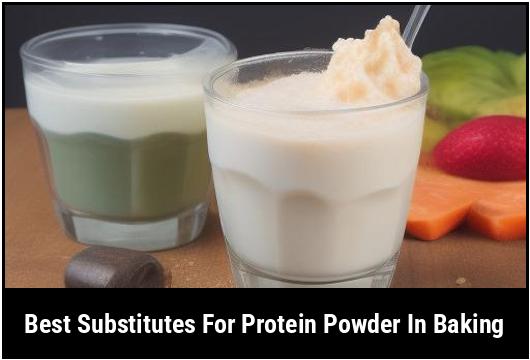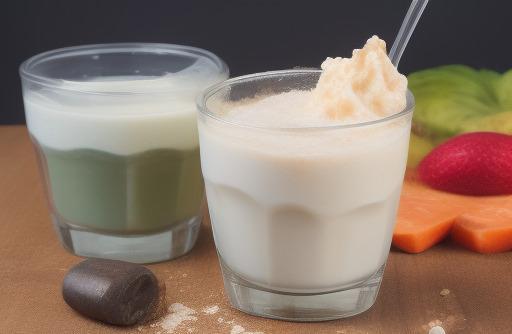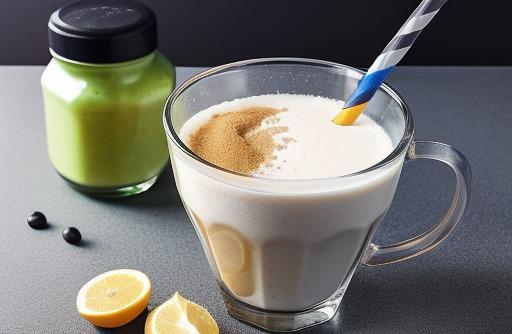Best Substitutes For Protein Powder In Baking

Protein powder has become a popular ingredient in the baking world, known for its ability to add protein, texture, and nutritional value to baked goods. However, there are times when you may not have protein powder on hand or prefer to use a natural alternative. In this article, we will explore the best substitutes for protein powder in baking, their uses, and how to incorporate them into your recipes.
Key Takeaways
- Protein powder is commonly used in baking to add protein and texture to baked goods.
- There are several substitutes for protein powder in baking, including nut flours, yogurt, cottage cheese, and beans.
- When choosing a substitute, consider the flavor, texture, and nutritional content of the ingredient.
- Experiment with different substitutes to find the one that works best for your specific recipe.
Why You Need A Substitute For Protein Powder In Baking
Protein powder is often used in baking to boost the nutritional content of baked goods, particularly for fitness enthusiasts or those looking to increase their protein intake. However, there are several reasons why you might need a substitute for protein powder:
- Unavailability or Allergies: Protein powder may not be readily available in all areas, or you might have an allergy or sensitivity to certain types of protein powder.
- Desire for Natural Ingredients: Many people prefer using natural ingredients in their baking rather than processed protein powders.
- Flavor: Some protein powders have a distinct flavor that might not be desirable in certain recipes.
- Texture: Depending on the recipe, protein powder can change the texture of the final baked goods. Using a substitute can help you achieve the desired texture.
Types Of Substitutes For Protein Powder In Baking

When substituting for protein powder in baking, it’s important to select an ingredient that provides similar nutritional benefits and can achieve a similar texture. Here are some common types of substitutes for protein powder in baking:
- Nut Flours: Ground nut flours, such as almond, cashew, or hazelnut, can be used as a protein powder substitute. They add not only protein but also a rich flavor to baked goods. Nut flours also provide a slightly nutty texture to the final product.
- Greek Yogurt: Greek yogurt is a nutrient-dense substitute for protein powder that adds moisture and protein to baked goods. It works particularly well in recipes that require a thick and creamy consistency, such as muffins and cakes.
- Cottage Cheese: Cottage cheese is another excellent substitute for protein powder in baking. It adds protein and moisture to recipes, resulting in moist and tender baked goods. Cottage cheese can be blended until smooth or mixed with other wet ingredients for a smooth texture.
- Beans: Pureed beans, such as black beans or chickpeas, can be used as a protein powder substitute. They add protein, fiber, and moisture to baked goods while keeping them soft and moist. However, this substitute might alter the flavor of the final product.
Best Substitutes For Protein Powder In Baking
Now let’s delve into the best substitutes for protein powder in baking and explore their characteristics, uses, and benefits.
1. Nut Flours
Nut flours are ground nuts that provide not only protein but also a rich flavor to baked goods. Almond flour, cashew flour, and hazelnut flour are commonly used as substitutes for protein powder. These flours are gluten-free and high in healthy fats, making them a nutritious option.
Characteristics: Nut flours have a slightly heavier texture compared to regular flour, which can result in denser baked goods. They have a subtle nutty flavor that works well in recipes such as cookies, cakes, and muffins.
Uses: Nut flours can be used as a one-to-one substitute for protein powder. They can replace protein powder in recipes that require a dry ingredient, such as protein bars, energy balls, or pancakes. Nut flours are particularly suitable for recipes where you want to enhance the flavor and add a bit of texture.
Benefits: Nut flours offer a good source of protein, healthy fats, and fiber. They are also low in carbohydrates and can be a suitable option for those following a low-carb or gluten-free diet.
Pro Tip: To achieve the best results when using nut flours as a substitute for protein powder, combine them with a lighter flour, such as coconut flour or oat flour. This will help balance the texture and prevent the baked goods from becoming too dense.
2. Greek Yogurt
Greek yogurt is a versatile and nutritious substitute for protein powder in baking. It adds protein, moisture, and a tangy flavor to your baked goods. Greek yogurt also contributes to a tender and moist texture, making it a popular choice for muffins, cakes, and bread.
Characteristics: Greek yogurt has a thick and creamy consistency, which adds moisture to baked goods. It has a tangy flavor, so it’s important to consider this when using it as a substitute.
Uses: Greek yogurt can be used as a one-to-one substitute for protein powder. It works well in recipes where moisture and thickness are desired, such as muffins, cakes, and quick bread. Greek yogurt can also replace eggs in some recipes, providing a vegan-friendly option.
Benefits: Greek yogurt is an excellent source of protein, probiotics, and essential nutrients like calcium. It adds nutritional value to your baked goods, making them more wholesome.
Pro Tip: When substituting protein powder with Greek yogurt, keep in mind that the tangy flavor might alter the taste of the final product. Adjust the sweetness of the recipe accordingly to balance the flavors.
3. Cottage Cheese
Cottage cheese is a unique substitute for protein powder that adds protein and moisture to baked goods. It works particularly well in recipes that require soft and moist textures, such as cookies and bread.
Characteristics: Cottage cheese can be blended until smooth or left slightly chunky, depending on the desired texture. When blended, it adds moisture and protein without altering the flavor significantly. However, if used as a chunky substitute, the cottage cheese may leave small curds in the baked goods.
Uses: Cottage cheese can be used as a one-to-one substitute for protein powder in recipes where moisture and tenderness are desired. It works well in cookies, bread, and brownies, providing a rich and moist texture.
Benefits: Cottage cheese is a good source of protein and low in fat. It also contains essential amino acids, vitamin B12, and calcium, making it a nutritious substitute for protein powder.
Pro Tip: To ensure a smooth texture, blend the cottage cheese until creamy before using it in your recipes. This will help incorporate it seamlessly into the batter, leaving no trace of curds.
4. Beans
Pureed beans, such as black beans or chickpeas, can be used as a protein powder substitute in baking. They add protein, fiber, and moisture to baked goods while keeping them soft and moist.
Characteristics: Pureed beans have a thick and creamy consistency that adds moisture and thickness to recipes. However, the flavor of beans may be more pronounced in the final product, which could be undesirable for some recipes.
Uses: Beans can be used as a one-to-one substitute for protein powder in recipes that can benefit from moisture and tenderness, such as brownies, cookies, and cakes. They work particularly well in recipes where a slightly denser texture is desired.
Benefits: Beans are an excellent source of plant-based protein, fiber, and nutrients like iron and folate. They add nutritional value to your baked goods and are a suitable option for those following a vegan or vegetarian diet.
Pro Tip: To minimize the flavor of beans in your baked goods, opt for milder varieties like black beans or white beans. Rinse and drain canned beans to remove excess salt or flavors before pureeing them.
Choosing The Right Substitute For Protein Powder In Baking

When choosing a substitute for protein powder in baking, consider the flavor, texture, and nutritional content of the substitute. Here are some factors to keep in mind:
- Flavor: Protein powder can have a distinct flavor that may not work well in all recipes. Choose a substitute that complements the flavors of your recipe or one with a neutral taste.
- Texture: Consider the desired texture of your baked goods. Some substitutes, like nut flours, can add a bit of texture and density, while others, like Greek yogurt, can lend moisture and tenderness.
- Nutritional Content: If you are using protein powder for its nutritional benefits, choose a substitute that offers similar nutrients. Nut flours, Greek yogurt, and cottage cheese are all good sources of protein.
Experimenting with different substitutes is a great way to find the one that works best for your specific recipe. Consider the overall characteristics, taste, and texture you want to achieve in your baked goods.
Cooking With Substitutes For Protein Powder In Baking
When using substitutes for protein powder in baking, it’s important to make a few adjustments to your recipe. Here are some tips to ensure successful results:
- Measurements: Substitute the protein powder with an equal amount of the chosen substitute. For example, if a recipe calls for 1/4 cup of protein powder, use 1/4 cup of the substitute.
- Texture and Consistency: Keep in mind that protein powder adds a dry and powdery texture to recipes. When using a substitute like Greek yogurt or cottage cheese, the batter may be slightly wetter. Adjust the other wet and dry ingredients to achieve the desired consistency.
- Baking Time: Depending on the substitute used, the baking time may vary slightly. Keep an eye on your baked goods and adjust the baking time accordingly.
Remember that each substitute has its own unique characteristics, so it’s essential to experiment and adjust the recipe as needed. Keep notes for future reference, and don’t be afraid to try different combinations to achieve the best results.
Recipes Using Substitutes For Protein Powder In Baking

Now that you’re familiar with the best substitutes for protein powder in baking, here are a few recipe ideas to get you started:
1. Almond Flour Chocolate Chip Cookies
Ingredients:
- 2 cups almond flour
- 1/2 cup granulated sweetener (such as erythritol)
- 1/2 teaspoon baking soda
- Pinch of salt
- 1/4 cup melted coconut oil
- 1/4 cup sugar-free maple syrup
- 1 teaspoon vanilla extract
- 1/2 cup sugar-free chocolate chips
Instructions:
- Preheat the oven to 350°F (175°C) and line a baking sheet with parchment paper.
- In a bowl, whisk together the almond flour, sweetener, baking soda, and salt.
- In a separate bowl, mix the melted coconut oil, sugar-free maple syrup, and vanilla extract.
- Combine the wet and dry ingredients, then fold in the sugar-free chocolate chips.
- Scoop the dough onto the prepared baking sheet and flatten slightly.
- Bake for 10-12 minutes, or until golden brown around the edges.
- Allow the cookies to cool on the baking sheet before transferring to a wire rack.
2. Greek Yogurt Banana Bread
Ingredients:
- 1 1/2 cups all-purpose flour
- 1/2 cup granulated sugar
- 1 teaspoon baking powder
- 1/2 teaspoon baking soda
- 1/4 teaspoon salt
- 1/2 teaspoon ground cinnamon
- 2 ripe bananas, mashed
- 1/2 cup plain Greek yogurt
- 1/4 cup melted butter
- 1 teaspoon vanilla extract
- 1/2 cup chopped walnuts (optional)
Instructions:
- Preheat the oven to 350°F (175°C) and grease a loaf pan.
- In a large bowl, whisk together the flour, sugar, baking powder, baking soda, salt, and cinnamon.
- In a separate bowl, combine the mashed bananas, Greek yogurt, melted butter, and vanilla extract.
- Gradually add the wet ingredients to the dry ingredients and mix until just combined. Do not overmix.
- Fold in the chopped walnuts, if using.
- Pour the batter into the greased loaf pan and smooth the top.
- Bake for 50-60 minutes, or until a toothpick inserted into the center comes out clean.
- Allow the banana bread to cool in the pan for 10 minutes before transferring it to a wire rack to cool completely.
3. Black Bean Brownies
Ingredients:
- 1 can black beans (15 ounces), rinsed and drained
- 2 large eggs
- 1/4 cup melted coconut oil
- 1/2 cup cocoa powder
- 1/2 cup granulated sweetener (such as stevia or erythritol)
- 1 teaspoon vanilla extract
- 1/2 teaspoon baking powder
- Pinch of salt
- 1/2 cup sugar-free chocolate chips
Instructions:
- Preheat the oven to 350°F (175°C) and line a baking dish with parchment paper.
- In a blender or food processor, puree the black beans until smooth.
- In a large bowl, whisk together the eggs, melted coconut oil, cocoa powder, sweetener, vanilla extract, baking powder, and salt.
- Fold in the pureed black beans and sugar-free chocolate chips.
- Pour the batter into the prepared baking dish and smooth the top.
- Bake for 20-25 minutes, or until a toothpick inserted into the center comes out with a few crumbs.
- Allow the brownies to cool completely before cutting into squares.
These recipes are just a starting point. Feel free to swap out the substitutes as desired and experiment with your favorite flavors and textures. Remember to adjust the other ingredients and baking time accordingly for the best results.
Storage And Shelf Life Of Substitutes
When using substitutes for protein powder in baking, it’s important to consider the storage and shelf life of the ingredients. Here are some general guidelines:
- Nut flours: Store nut flours in an airtight container in a cool, dark place, such as the pantry. They can also be stored in the refrigerator or freezer for longer shelf life. Nut flours can usually be kept for several months if stored properly.
- Greek yogurt and cottage cheese: Once opened, these ingredients should be stored in the refrigerator and consumed within a week. Greek yogurt and cottage cheese can also be frozen for up to three months. However, note that freezing may affect the texture and consistency, so they may not be suitable for all recipes after thawing.
- Beans: Canned beans should be stored in a cool, dry place, such as the pantry. Once opened, transfer any unused beans to an airtight container and refrigerate for up to five days. Pureed beans can be frozen for up to three months.
Always check the packaging or consult specific storage guidelines for each individual ingredient to ensure maximum freshness and quality.
Conclusion
Protein powder is a popular ingredient in baking, but it’s not the only option. Nut flours, Greek yogurt, cottage cheese, and beans can all be used as substitutes for protein powder, adding protein, moisture, and flavor to your baked goods. When choosing a substitute, consider the flavor, texture, and nutritional content of the ingredient. Experiment with different substitutes and adjust your recipe as needed to achieve the desired results. Happy baking!
Pro Tip: When using nut flours as a substitute for protein powder, aim for blanched or finely ground varieties. These will provide a smoother texture and better incorporation into your baked goods.
FAQS
What Are Some Good Substitutes For Protein Powder In Baking Recipes?
If you don’t have any protein powder on hand or simply want to avoid it, there are several other ingredients that can add protein and moisture to your baked goods. Some popular options include Greek yogurt, cottage cheese, silken tofu, nut butter, and black beans. Each of these can be easily incorporated into recipes to create a nutritious and satisfying treat.
How Can I Use Greek Yogurt As A Substitute For Protein Powder In Baking?
Greek yogurt is a versatile ingredient that can be used in a variety of baking recipes. To substitute for protein powder, simply use 1/4 cup of Greek yogurt in place of 1 scoop of protein powder. Greek yogurt is high in protein and has a creamy texture, making it an excellent addition to muffins, cake, and other baked goods.
Can Cottage Cheese Be Used In Place Of Protein Powder In Baking Recipes?
Yes, cottage cheese can be used as a substitute for protein powder in baking. It is a good option for those who prefer a less processed ingredient and want a natural source of protein. To use cottage cheese in baking, blend 1/4 – 1/2 cup of cottage cheese with a small amount of milk or water until it forms a smooth consistency. This mixture can be added to recipes in place of protein powder.
What Is Silken Tofu And How Can It Be Used In Baking Recipes?
Silken tofu is a type of tofu that has a creamy, smooth texture and is often used in vegan and vegetarian dishes. It can also be used as a substitute for protein powder in baking recipes. To use silken tofu, simply blend 1/4 – 1/2 cup of tofu with a small amount of liquid until it forms a smooth consistency. This mixture can be added to recipes in place of protein powder for a protein boost.
Are There Any Nut Butters That Can Be Used As A Substitute For Protein Powder In Baking?
Yes, nut butters such as almond, peanut, and cashew butter can be used as a substitute for protein powder in baking. They are high in protein and have a rich, nutty flavor that can add depth to baked goods. To use nut butter in baking, simply replace 1 scoop of protein powder with 2 tablespoons of nut butter. You may need to adjust the amount of liquid in the recipe to achieve the desired consistency.
Sources
About the Author Jenny
I'm Jenny, a housewife with an unwavering passion for food. My culinary journey began with my grandmother's kitchen, and it's now a full-fledged food blog. I've turned my love for cooking into a creative outlet, sharing recipes and stories with a global community of fellow food enthusiasts. It's proof that being a housewife can also mean pursuing your passions and savoring life's delectable moments.
